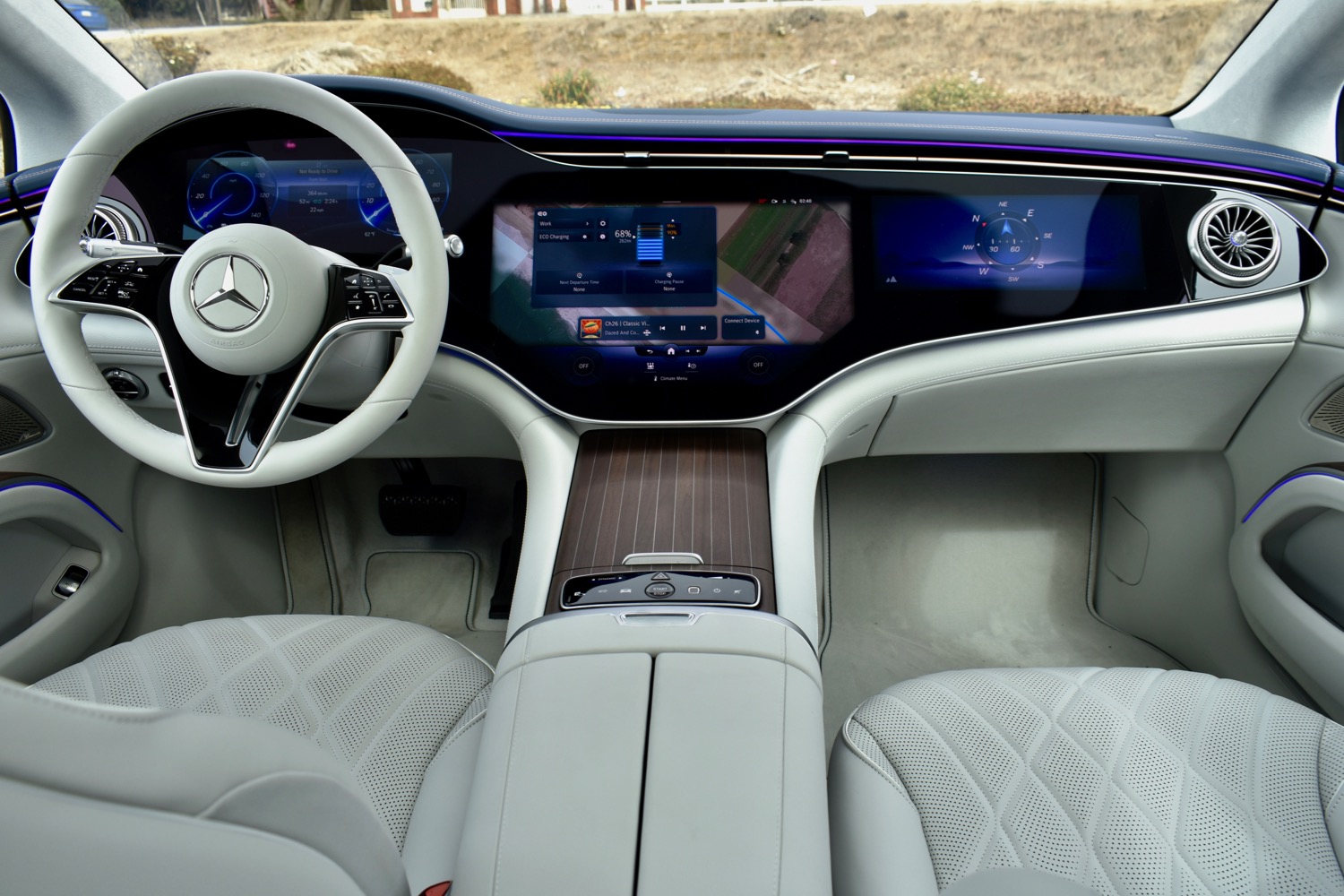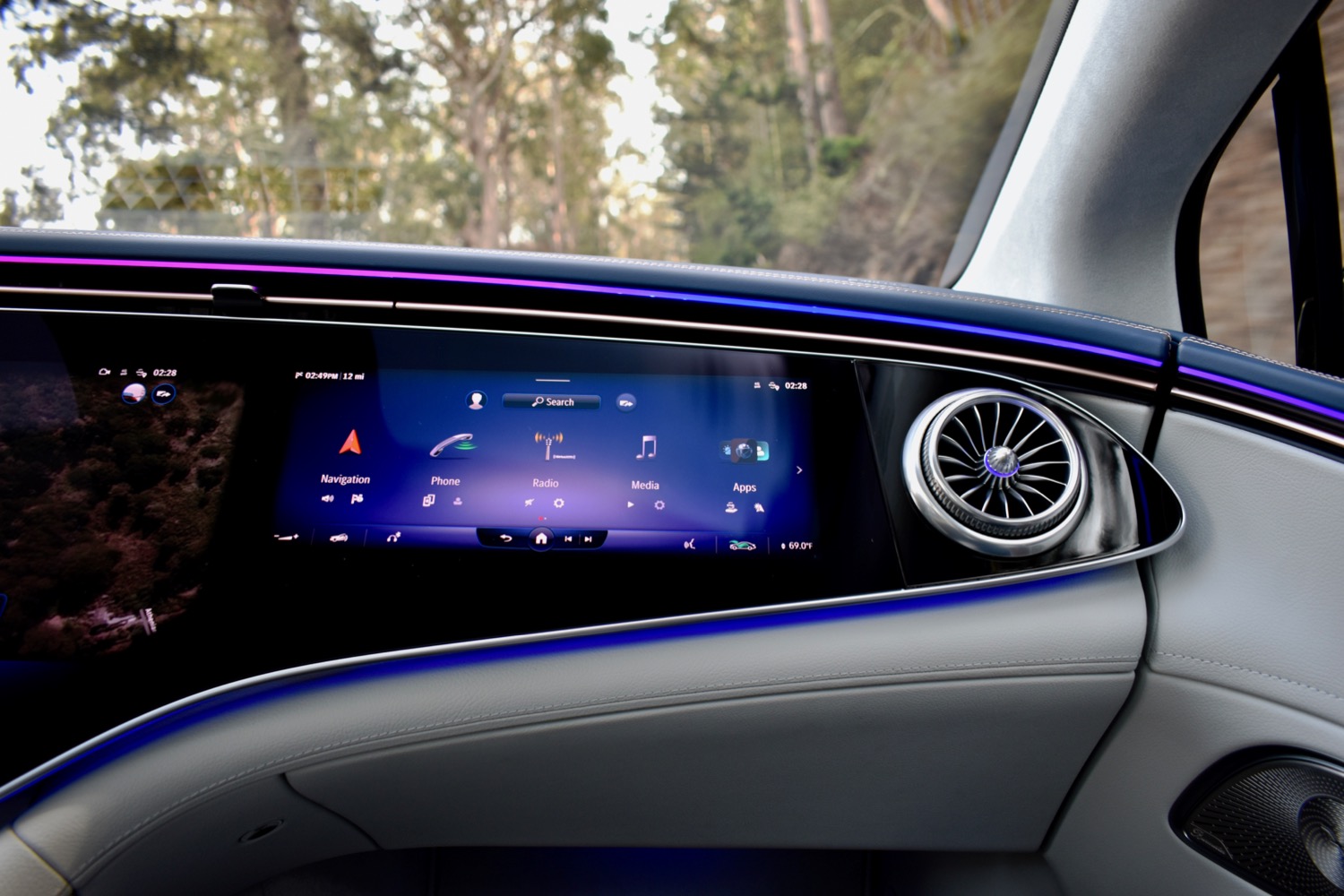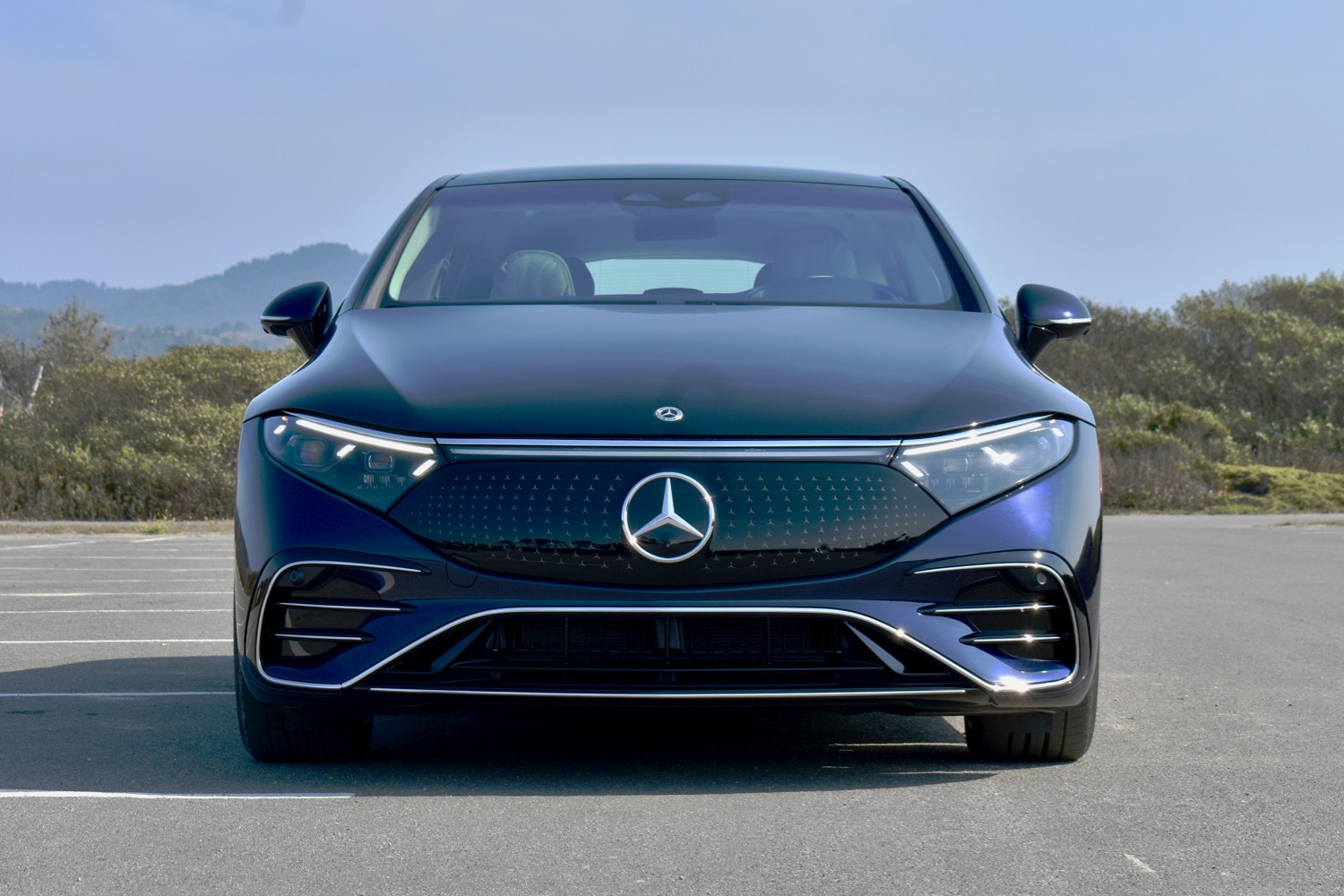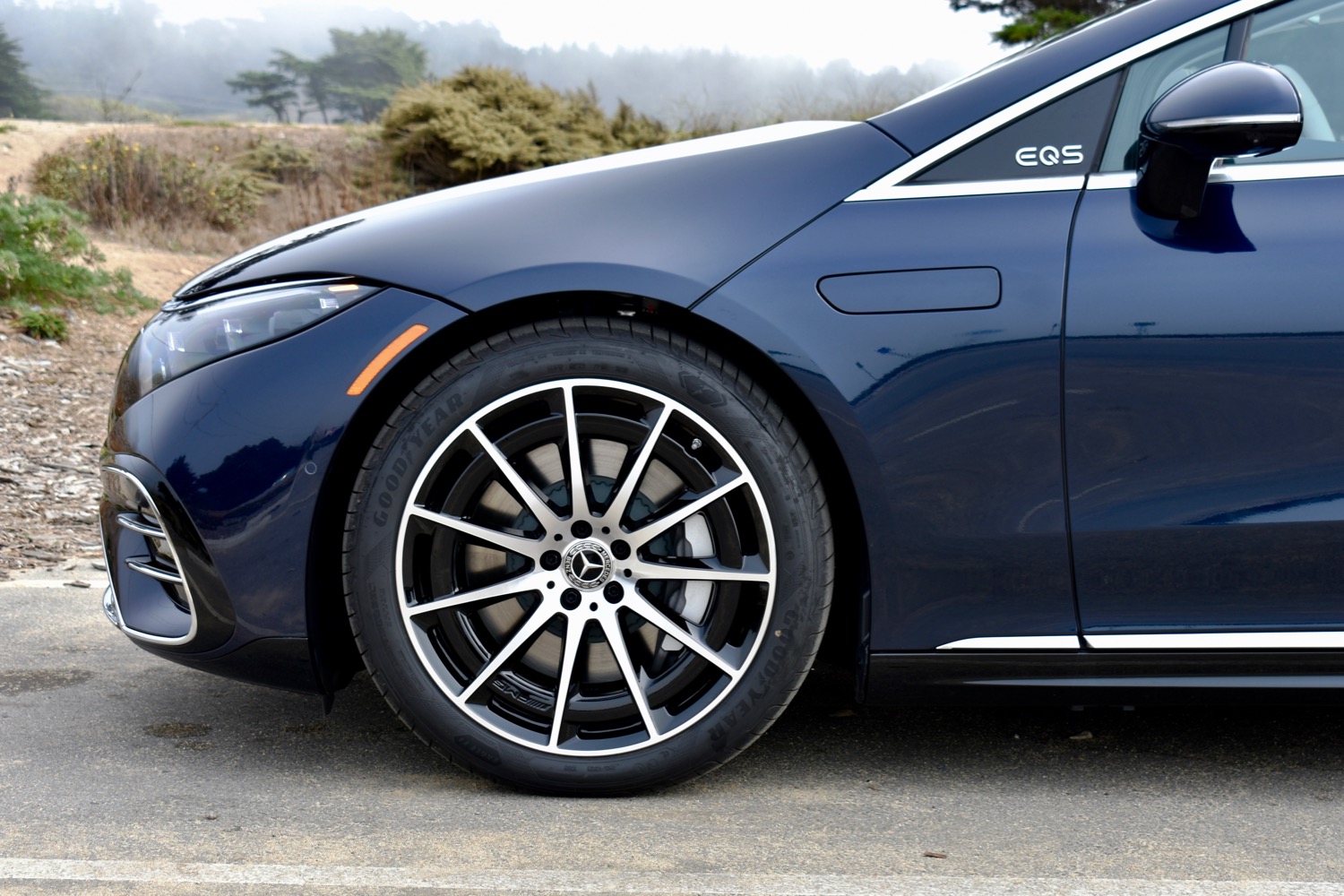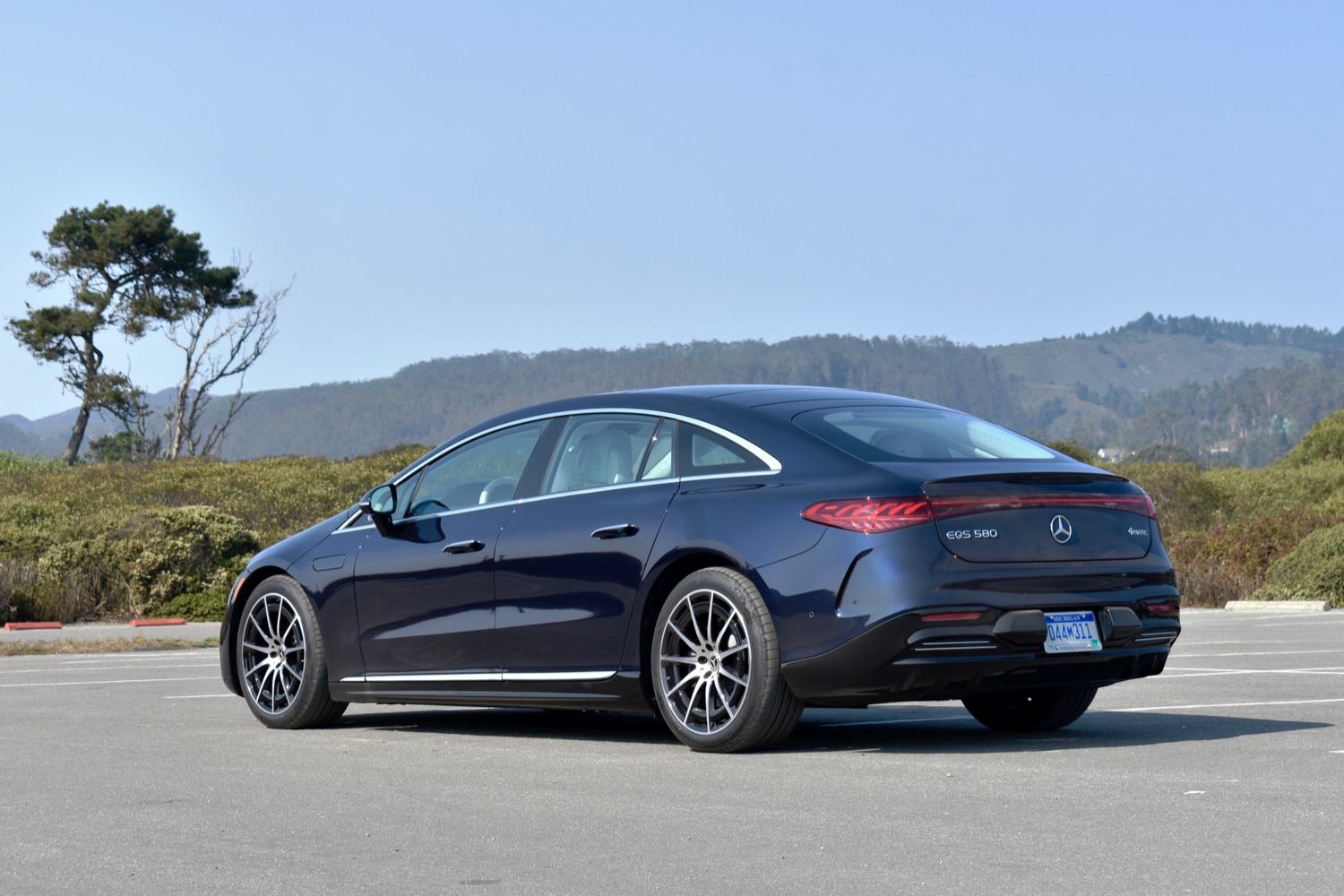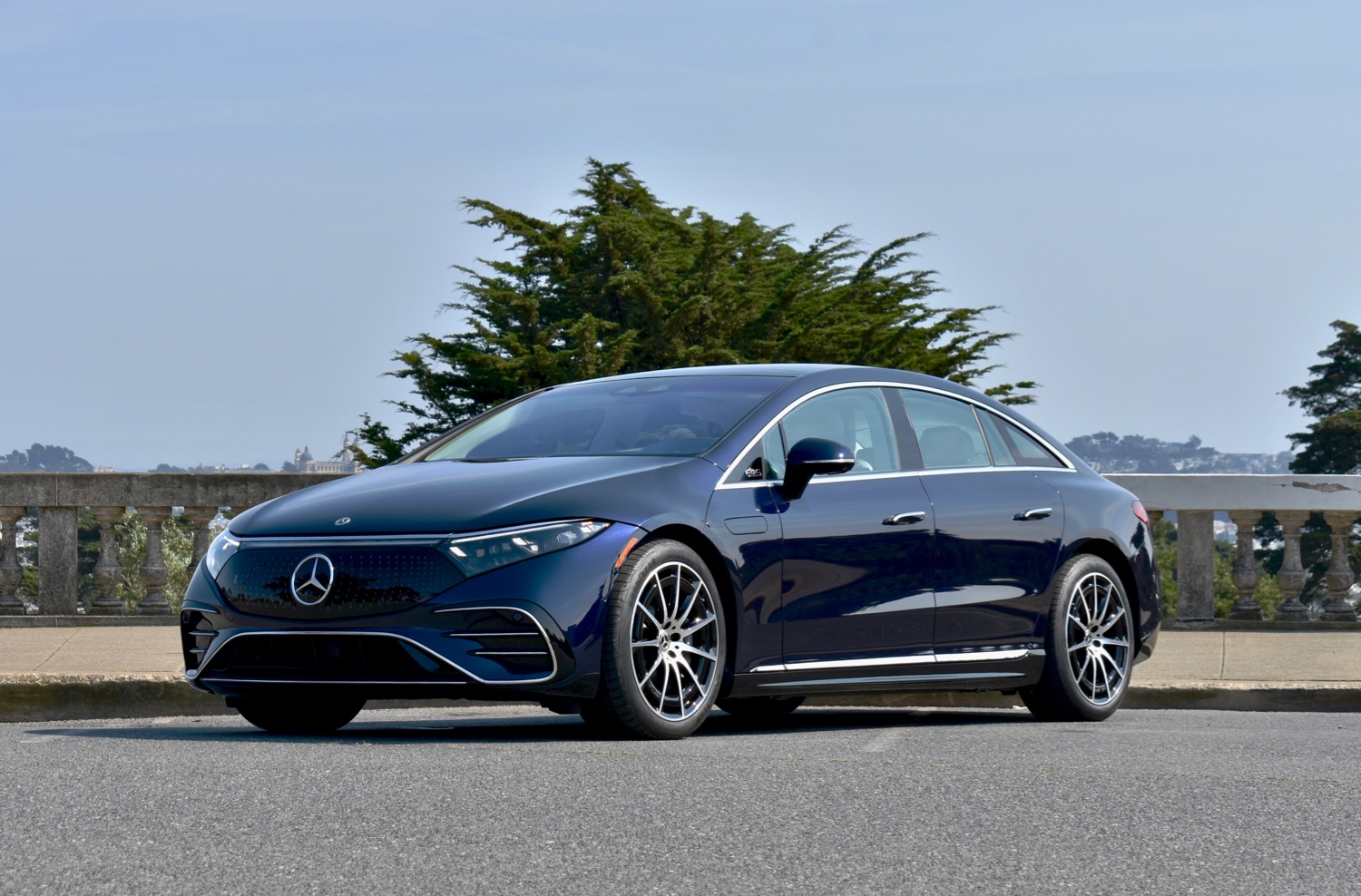
A Mercedes-Benz electric sedan was inevitable. The meteoric success of the Tesla Model S, plus stricter European emissions standards gave Mercedes no choice but to meet Tesla on the EV battlefield. But a company that’s been building cars for over 100 years doesn’t rush into anything.
The 2022 Mercedes-Benz EQS sedan is our first glimpse at the automaker’s electric future. It heralds a range of electric cars for North America (including an EQS SUV) and showcases new technology, including the largest infotainment touchscreen ever fitted to a production car. Mercedes didn’t choose the name EQS by accident. “EQ” is the automaker’s electric sub-brand, while “S” signifies that this car is the electric equivalent to Mercedes’ traditional flagship, the S-Class sedan.
The EQS reaches dealerships in the United States later this fall. Mercedes plans to offer a base single-motor EQS 450+ version and a dual-motor EQS 580 model, starting at $103,360 and $120,160 MSRP, respectively. We got to try out both over two days of driving around San Francisco and Silicon Valley.
Design and interior
The EQS looks like no other Mercedes and, unlike the recently launched BMW iX electric SUV, the styling isn’t just about creating an artificially futuristic look. Mercedes took a holistic approach to efficiency, and it starts with the pill-shaped bodywork. That allows for a drag coefficient of just 0.20, which minimizes aerodynamic drag and helps maximize range.
While it may look unconventional on the outside, on the inside the EQS is every inch a Mercedes. You get leather seats with 10 massage programs, a panoramic roof, and available 64-color ambient lighting that makes the interior look like a futuristic nightclub. If you prefer to be chauffeured, the Pinnacle trim level adds power-adjustable rear seats with heating and ventilation, plus rear USB-C ports and wireless phone charging. Those features are piled on top of a dramatic design. The windshield and doors seem to wrap around the dashboard, while the massive touchscreen appears to float off of it.
The pill-shaped bodywork minimizes aerodynamic drag and helps maximize range.
The stubby hood doesn’t open, so you don’t get a “frunk” like on other EVs. And while it’s billed as a sedan, the EQS actually has a rear hatch, making for a long but narrow cargo area. At 22.0 cubic feet, that affords substantially more cargo space than the internal-combustion Mercedes S-Class sedan.
The EQS and S-Class are pretty much identical in size, with the S-Class measuring slightly longer and the EQS standing a bit taller (likely due to the packaging requirements of the battery pack). Mercedes hasn’t published complete interior dimensions for the EQS, but it does quote identical front legroom to the S-Class, with slightly less front headroom.
Tech, infotainment, and driver assist
The EQS raises the bar for infotainment tech with its Mercedes-Benz User Experience (MBUX) Hyperscreen display. Standard on the EQS 580 and optional on the EQS 450+, the 56-inch curved OLED display is the largest ever in a production car.
The Hyperscreen actually combines three separate displays, including a 12.3-inch digital instrument cluster, 17.7-inch central touchscreen, and a 12.3-inch touchscreen for the front passenger. Everything is covered by Gorilla Glass with a scratch-resistant coating, and backed by 12 actuators for haptic feedback, eight CPU cores, and 24GB of RAM. Wireless Apple CarPlay and Android Auto are standard, along with a Burmester audio system.
Functions are organized by what Mercedes calls the “Zero Layer” concept. Instead of a home screen with menu icons, the central touchscreen shows navigation maps (with available satellite imagery) by default, with other functions like climate control and audio displayed in smaller boxes below. The passenger screen—which only turns on when someone is sitting in the seat—gets a more conventional layout, while the instrument cluster can be reconfigured to show traditional dials, maps, and other information.
The EQS raises the bar for infotainment tech with its Hyperscreen display.
If this sounds like a lot, that’s because it is. Having so many functions on the screen at once means you don’t have to dig through menus, but we found it still took a bit to locate everything. Some functions, such as drive modes and audio volume, also required using an awkwardly-placed touchpad on the center console. The EQS does have the same natural-language voice control system as other Mercedes models, but we found it to be unusually slow to respond here.
The Hyperscreen itself was very responsive, though, and we liked some of Mercedes’ design choices, such as the pulsating lights that replace the instrument-cluster dials when you switch the EQS into Sport mode. Having a separate screen for the front passenger also makes sense. It lets them fiddle with individual settings more easily, and allows for separate audio streaming to a connected pair of Bluetooth headphones. The EQS can also be equipped with the same augmented-reality head-up display as the S-Class, which projects arrows showing where to turn when using the navigation system.
All EQS models get a standard Driver Assistance Package that includes adaptive cruise control with steering assist, blind-spot monitoring, lane-keep assist, a driver-attention monitor, parking assist, and a surround-view camera system.
Driving experience
The base EQS 450+ generates 329 horsepower and 419 pound-feet of torque from its single motor, which powers the rear wheels. The EQS 580 uses one motor to power each axle, enabling all-wheel drive and a total system output of 516 hp and 631 lb-ft of torque. Both versions use the same battery pack, with 107.8 kilowatt-hours of usable capacity.
Mercedes quotes zero to 60 mph times of 5.9 seconds for the EQS 450+ and 4.1 seconds for the EQS 580 (both models are limited to 130 mph). Those acceleration times don’t come close to the quickest Tesla Model S, or the forthcoming Lucid Air Dream Edition, but the numbers don’t tell the whole story.
Mercedes devised some sound effects that would make George Lucas proud.
Standard air suspension gives the EQS the smooth, pothole-erasing ride you should expect from a big luxury sedan. Yet this car doesn’t flinch when you show it a corner. Mercedes also gave the EQS the rear-wheel steering system from the S-Class, which makes it surprisingly agile. The floor-mounted battery pack keeps most of the weight low, giving the EQS a sure-footed feel. While the EQS did feel somewhat floaty in its default driving mode, switching to Sport mode cured that, without any noticeable impact on ride quality.
Like all electric cars, the instant torque on the EQS also makes it feel quicker than the numbers suggest. Even the base EQS 450+ will throw you back in your seat, and instead of the tired old internal-combustion soundtrack, Mercedes devised some sound effects that would make George Lucas proud. It’s been said that many cars accelerate like spaceships, but the EQS may be the first that sounds like one. Tesla can keep its fart noises.
Range, charging, and safety
Official range figures are 350 miles for the EQS 450+ and 340 miles for the EQS 580 (efficiency ratings weren’t available at the time of publication). That’s less than the longest-range versions of the Model S or Lucid Air, but more than the similarly-priced Audi E-Tron GT and Porsche Taycan.
The EQS can charge at 9.6 kilowatts on a 240-volt Level 2 AC source. That’s a lower rate than some other EVs, and means a 10% to 100% charge takes just over 11 hours, according to Mercedes. The EQS is also equipped for DC fast charging at 200kW, allowing for a 10% to 80% charge in 30 minutes, per Mercedes. Owners can use Plug & Charge to start a charging session by simply plugging in (after pre-setting a payment method), and Mercedes is offering an unlimited number of free 30-minute charging sessions on the Electrify America network for two years.
Crash-test results from the Insurance Institute for Highway Safety (IIHS) and National Highway Traffic Safety Administration (NHTSA) aren’t available yet. The EQS is a new model, and high-priced cars like this generally aren’t a priority for the safety organizations.
The EQS gets the same four-year, 50,000-mile, new-vehicle warranty as other Mercedes models, plus a 10-year, 155,000-mile, battery warranty. That exceeds the maximum eight-year, 150,000-mile, battery warranty Tesla offers for the Model S.
How DT would configure this car
Our ideal configuration would start with the base EQS 450+ model. While it does sacrifice all-wheel drive and 1.8 seconds in the zero to 60 mph sprint, the single-motor 450+ gains 10 miles of range, and offers more-than-adequate performance, in our opinion.
However, the EQS 450+ doesn’t get the Hyperscreen as standard equipment, so we’d add that (for $7,200) along with active ambient lighting ($590). We’d also upgrade from the entry-level Premium version to the Exclusive, netting massaging front seats, a head-up display, and four-zone automatic climate control for an additional $3,400. Add in the mandatory $1,050 destination charge, and you end up with an MSRP of just under $115,000.
Our take
The EQS is a significant step in the evolution of electric cars. Unlike most EVs from established luxury brands, it feels new and different, rather than just an electric version of an existing model. It also provides an unmatched level of luxury, truly making it the electric equivalent of Mercedes’ flagship S-Class.
In some areas, the EQS surpasses its gasoline counterpart. The Hyperscreen infotainment system offers more of everything, and the EQS is also nicer to drive than the S-Class. It has all of the smoothness and refinement of that sedan, but with even better handling and the EV party trick of instant torque. The EQS’ back seats didn’t feel as spacious, thanks to a lower roof line and higher seat placement, but we’ll have to wait for official measurements to confirm that.
The Tesla Model S may still win on range and performance, but the EQS has it beat on comfort and amenities. Consequently, the Mercedes feels more worthy of its six-figure price tag. The Lucid Air also promises a luxurious cabin, along with up to 520 miles of range, but it’s only just going into production, and thus remains a bit of an unknown.
Some of Mercedes’ German rivals have launched high-end electric sedans of their own, but the Audi E-Tron GT and Porsche Taycan fall short on range, and emphasize performance over luxury.
Should you get one?
Yes. The EQS is the future of luxury.
